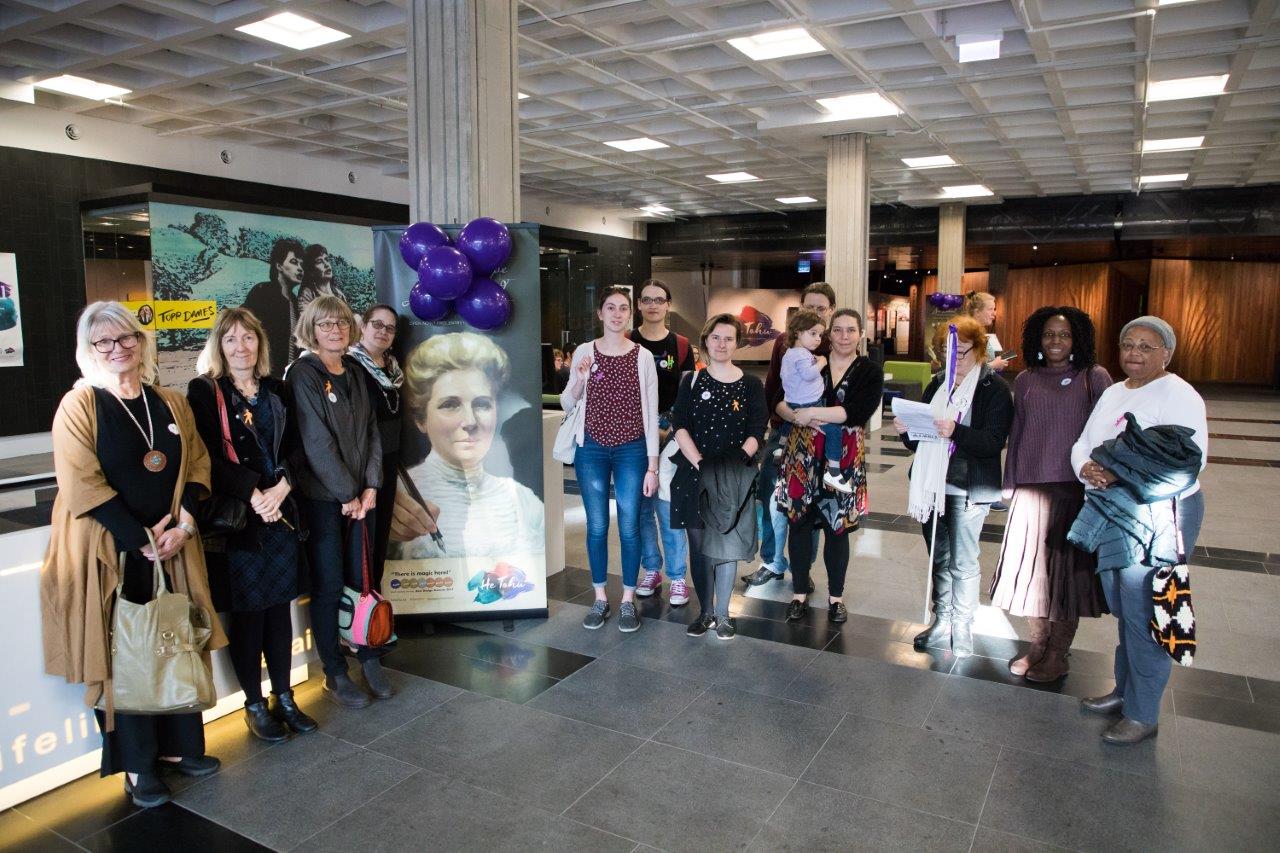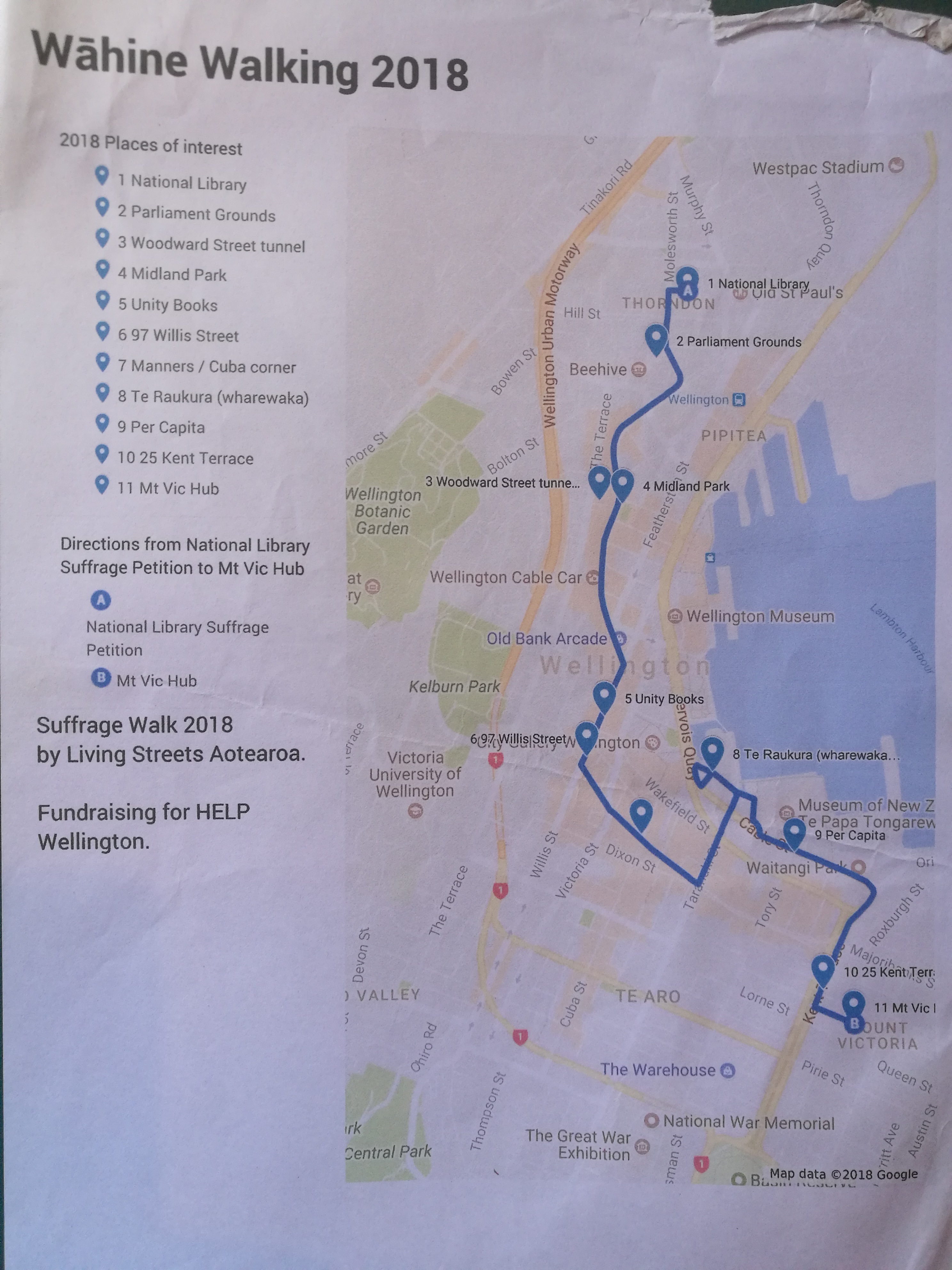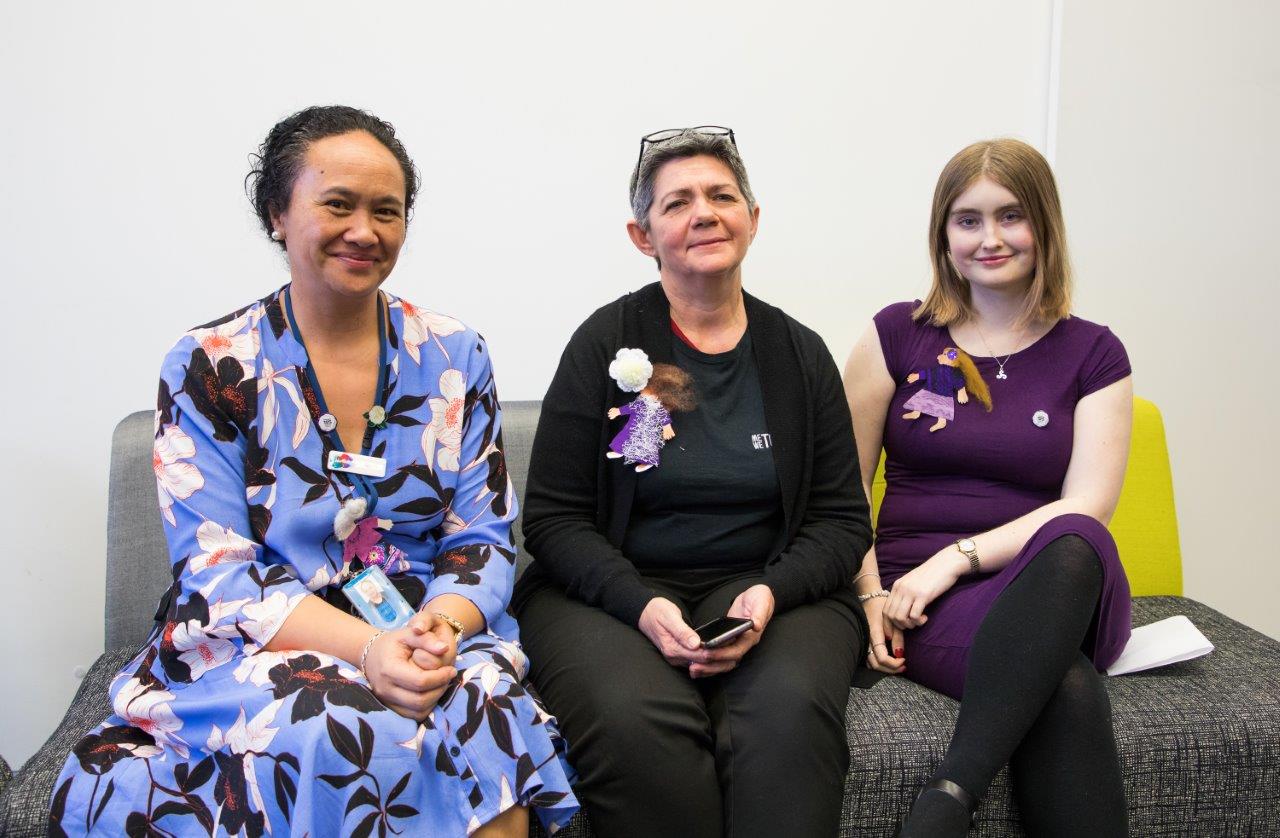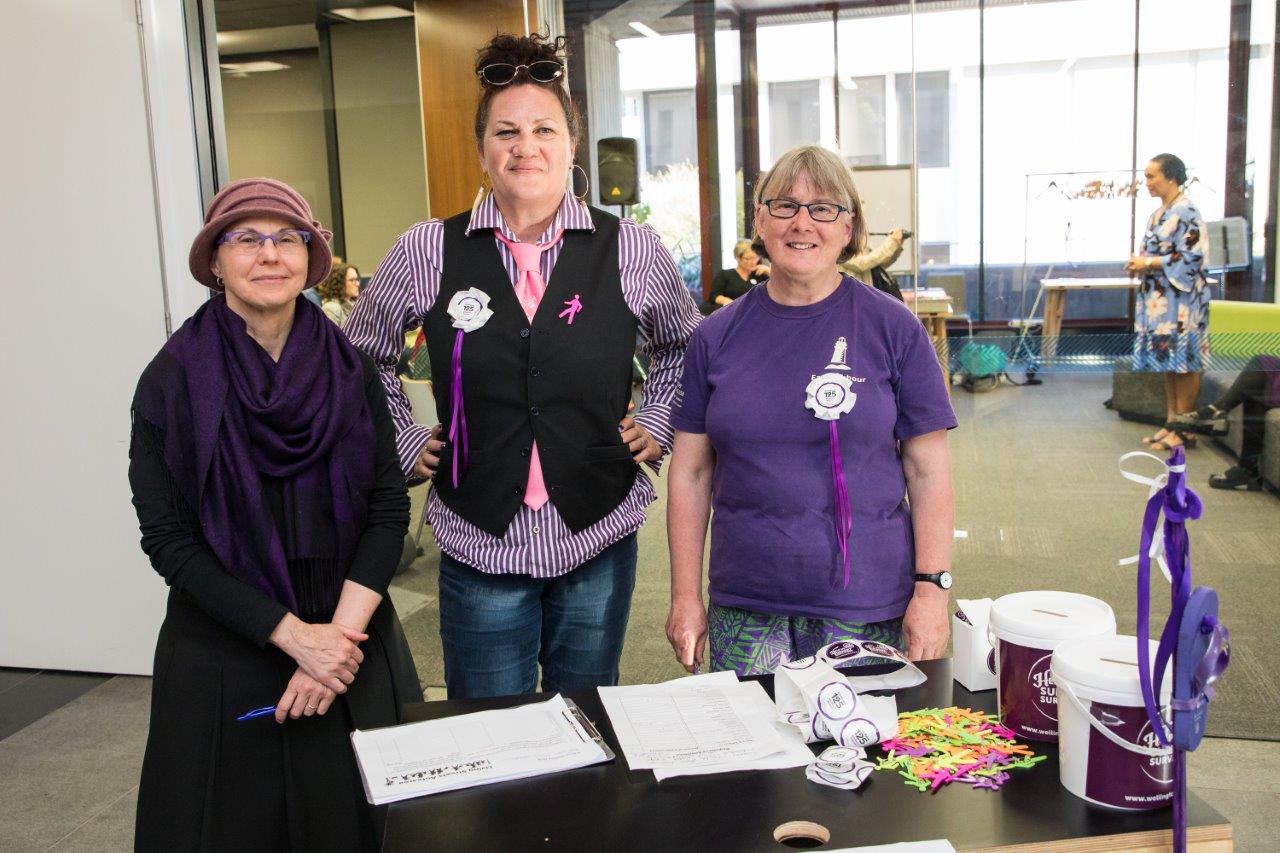This route was walked on Suffrage Day 19thSeptember 2018. Please enjoy walking this interesting route alone or in a group.

The stop numbers correspond to the map attached below. Directions are for an accessible route with controlled crossings.
National Library– as part of Te Tohu exhibition, the Suffrage Petition (1893) sits beautifully displayed along with the Treaty of Waitangi (1840) and the Declaration of Independence (1835). Kate Sheppard was a leading suffragist behind getting 32,000 signatures on the petition and ensuring that New Zealand became the first country where women could vote. There’s also a nice café and toilets available!
Cross Molesworth at the traffic lights downhill. Note that the green female walking figure represents Kate Sheppard. It was quite controversial to get New Zealand Transport Agency to agree the silhouette although the law says “a human figure” all others looked very male.
Enter Parliament Grounds at the main gate and head downhill on the path next to the hedge. Sonja Davies’ memorial tree is the first kowhai of this group. You can see her memorial plaque at its foot.
Sonja Davies tree
Sonja Davies ONZ was a nurse, women’s rights activist, trade unionist, peace campaigner and MP. This significant trailblazer was born in Upper Hutt in 1923 and died in Wellington in 2005. Recommended Bread and Roses, her autobiography and a film by Gaylene Preston.
Continue down the driveway, turn right and pass the Cenotaph, and then cross at the traffic lights. Walk along Lambton Quay to Woodward Street. Turn right up this shared space and stop by the Spinning Top sculpture.
Kumutoto Stream (undergrounded) byWoodward St tunnel
Here you can hear the soundscape, by artist Kedron Parker, installed in the tunnel, enabling people on foot to imagine walking along the stream before it was confined in concrete. Each of Wellington’s inner harbour streams (Waimapihi, Waitangi,Kumutoto, Pipitea, Waipiro, Moturoa, Kaiwharawhara) had different uses in pre-European times. Kumutoto was used by women during childbirth.
Return down Woodward Street and cross Lambton Quay at the traffic lights, turning left in front of Midland Park.
Woman of Words, metal sculpture representing author Katherine Mansfield by Virginia King.
Katherine Mansfield was born in Wellington in 1888 and died of tuberculosis in 1923 at Fontainebleu, France.
“Katherine Mansfield revolutionised the 20th Century English short story. Her best work shakes itself free of plots and endings and gives the story, for the first time, the expansiveness of the interior life, the poetry of feeling, the blurred edges of personality. She is taught worldwide because of her historical importance but also because her prose offers lessons in entering ordinary lives that are still vivid and strong.”Damien Wilkins nzedge.com
Mansfield had two romantic relationships with women that are notable for their prominence in her journal entries. She continued to have male lovers and married twice. Her first same-sex romantic relationship was with Maata Mahupuku, a wealthy young Māori woman.
Sculptor Virginia King was born in Kawakawa. Amongst other educational attainments, she attended what was then the Wellington Polytechnic School of Design. The Wellington Sculpture Trust, in partnership with the Wellington City Council, has introduced many contemporary sculptures to the streets of the capital.
Walk south along the same side of Lambton Quay, crossing diagonally at the Barnes Dance lights onto the east side of Willis Street. Continue along Willis St until you reach Unity Books at 57. Enter through the front door.
Unity Books, an independent bookshop, has provided a wonderful selection of books and haven for browsers, launches for authors and signings by the famous – including Helen Clark. There are many relevant books including ones about the Suffrage Movement. Tilly Lloydis the owner and a true bibliophile, a stalwart of women’s liberation, co-founder of Hecate, health collective. “Our job is to keep this place animated and intelligent, like a desirable oasis.” Watch the video here.
Continue along Willis Street.
97 Willis Streeta location which was very visible from the newspaper offices once located opposite.
The site of a protest march – the 1973 Abortion Rally. The banner refers to gaining the vote 180 years before. Walk Radical Wellington links sites of protest, subversion and social struggle. This online self-guided walk won a Living Streets Aotearoa Golden Foot Award. https://pocketsights.com/tours/tour/Wellington-Walking-Radical-Wellington-1845
Continue along Willis Street then turn left into Manners Street and continue to Cuba Street, by Burger King.
Carmen Rupe traffic lights, installed in 2016 to pay tribute to the one-time stripper, gay rights advocate and 1977 Wellington mayoral candidate. Born Trevor Rupe in 1936, Carmen challenged discrimination when homosexuality and prostitution were both illegal. She was flamboyant and a friend to many vulnerable people. She died in Sydney in 2011. The lights were installed to mark the 30thAnniversary of the 1986 Homosexual Law Reform Act Watch the video here
Continue along Manners Street to Taranaki Street (to avoid the construction works in Civic Square). Note Te Aro Park’s tile sculpture representing a waka arrival by Shona Rapira-Davies. Turn left into Taranaki Street and proceed to the waterfront, crossing the quays at the lights.
Te Raukura, is the name of the building where the waka are housed. It also houses a function centre and cafe. This wharewaka was opened in 2011. To experience and share in the rich culture and history of Te Whanganui-a-Tara (Wellington) and Te Ātiawa/Taranaki whānui (tribe) you can book a waka (canoe) paddle or an informative walking tour. Te Hononga and Poutu are waka tētēkura: protocol means women are welcome to paddle them.
Go south along the waterfront. Walk past the Four Plinths sculptures and Te Papa and then along the footpath along the same side of Cable Street. Remain on the same side of the road but note Per Capita outside Museum hotel at the Tory Street corner.
Per Capita sculpture, Cable Street, by Wellington artist Cathryn Monro
This ten ton steel sculpture consists of four gigantic portraits. Two pieces are shaped as portraits in profile, and two have the profiles cut out from a square – i.e. two are in positive form and two in negative space - evoking, in the artist's words, “a visual conversation about the complexity of New Zealand's cultural identity.” The profiles are based on actual portraits of people who are connected through genealogy.
Continue along Cable Street, enjoying the native plants in Waitangi Park. This is a stormwater treatment wetland at the bottom of the now piped Waitangi Stream. The wetlands were designed by Megan Wraight, landscape architect, to clean the Waitangi Stream before it enters the harbour.
Cross Oriental Parade in two stages at the lights and walk past BATS, cross Majoribanks Street at the lights. Continue along Kent Terrace until you reach Saffron Haveli restaurant at 25 Kent Terrace. From here you can safely see
Queen Victoria statue, median strip of Cambridge/ Kent Terrace
data courtesy of Mt Victoria Historical Society and The Dominion Post
This bronze monument to Queen Victoria standing imperiously under power lines and bus lines between Kent and Cambridge terraces was Wellington's first significant sculpture and one of its most controversial. It now stands in the suburb named after the Queen but this wasn’t its first site.
It was planned after Victoria's death on January 22, 1901, and commissioned from one of Britain's most established artists, Edward Drury, best known for the figures of Queen Victoria and Prince Albert above the main entrance of London's Victoria and Albert Museum.
The Wellington monument was originally set in Post Office Square and unveiled in April 1905 by New Zealand's governor, Sir William Plunket, who liked to think the statue would welcome immigrants to the harbour like a modest Statue of Liberty. Unfortunately, it seems to have caused traffic issues with the trams in Post Office Square and was relocated to its present site.
The City Council put forward a plan to shift the statue back to Post Office Square. Post Office Square businesses and residents objected to the move and so did Mt Victoria residents. Local stalwarts Jim Harper and Alan Olliver were to the fore as research was done and submissions made. With the support of other heritage advocates they won the case.
More controversial is the statue's Aberdeen granite pedestal. In Britain this was hailed as an excellent example of its fine arts genre, but its four bronze reliefs have always stirred local debate. They show Drury's artistic interpretation of the signing of the Treaty of Waitangi. These are perfectly executed, but they have been seen as unacceptably glossing over the events of 1840. The statue remains an expression of values held in New Zealand's colonial past.
Queen Victoria is now regarded as a particularly fine example of high imperial statuary. Most importantly, for Wellingtonians, it is bigger than the one in Auckland.
Continue along Kent Terrace until you reach Elizabeth Street. Turn left and then use the zebra crossing by the school to arrive at our final destination.
Mt Vic Hub, Elizabeth Street – community co-ordinator Trish Given(toilet available – down steps)
Like many community centres, this one is led and co-ordinated by a woman. The Hub seeks to connect and support residents and make access to different spaces easily available. Mt Victoria’s community spaces (aka third places) include Tararua Tramping Club hall, Quakers Meeting Room, Clyde Quay School and Innermost Gardens,



